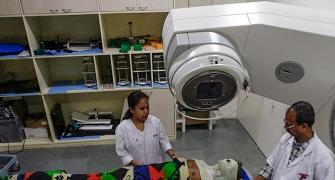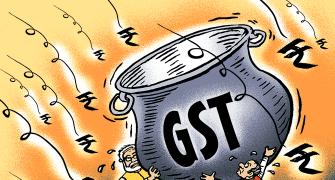The impact of GST is particularly stark in the highly fragmented synthetic textile industry, which attracts different GST rates at different stages of production and sale

At 40, Ashish Sukharawala has become an insurance agent and is still learning the ropes.
Until recently, he was a second generation weaver with 100 powerlooms in an industrial estate in Surat.
However, the heavy tax burden under the new goods and services tax (GST) regime and the resultant losses in his business have forced Sukharawala to sell his looms for scrap and rent out his premises to a plastic trader.
Sukharawala’s story is being replicated across Surat’s textile and diamond industries.
In the one year since the GST kicked in, many of the city’s powerloom owners have shut shop and small-time textile and diamond traders moved on to other businesses.
The once busy Ring Road, which houses wholesale textile markets, has less traffic now.
And the industrial estates that used to reverberate with the din of powerlooms are quieter.
The impact of the GST is particularly stark in the highly fragmented synthetic textile industry, which attracts different GST rates at different stages of production and sale.
The powerlooms have been hit the hardest as they are barred under the GST from seeking any input tax credit refund.
Textile traders have also taken a hit. From being out of the tax net in the pre-GST era, textile trading now attracts a 5 per cent GST.
And it is the small and medium traders, who constitute 90 per cent of Surat’s 75,000 textile traders, who are affected the most.
Their business has dropped by 40 per cent, points out Champalal Bothra, general-secretary of the Federation of Surat Textile Traders Association.
Many of these traders have gone into the employ of bigger traders or joined them to try and weather the GST storm.
“People are now trying their hand at catering, hardware agencies or plastic, or leasing their premises for warehousing. Once job creators, several entrepreneurs are now job seekers. There have been job losses in hundreds of thousands,” says Ashish Gujarati, president of the Pandesara Weavers’ Association.
Gujarati is also leasing part of his premises to a plastic-processing unit.
The statistics tell the story. Capacity utilisation in Surat’s textile industry, especially in jobs such as sizing, twisting, processing, and weaving, is down from 80-90 per cent in the pre-GST period to 40-50 per cent now. Of the 650,000 powerlooms in Surat, 100,000 have already been sold as scrap.
Payment cycles, too, have gone up from three-four months to six-eight months.
Again this time last year, Surat was producing 40 million metres of synthetic textiles per day. The output has now dropped to 25 million metres per day. Employment, too, has nosedived.
The roughly 1.7-1.8 million workers in the pre-GST days are down by 400,000-450,000. In fact, several migrant workers have returned to their native states.
“The blow from GST comes at a time when the synthetic apparel industry was witnessing declining demand. Over the last few years, the average synthetic fabric length per female buyer has come down from 6-7 metres to 2.5-3 metres in the case of saris and salwar suits,” says Jitu Vakharia, president of the South Gujarat Textile Processors Association.
All this, coupled with the price hike in yarn and chemicals, has affected the business so much that many units are now opting for staggered production.
“Earlier, they used to be shut once a fortnight. Now mills remain closed for two to three days a week,” says Vakharia.
Businesses across the textile and the diamond industries have been affected the most by having to wait for tax refunds to come through.
“Pending tax refunds have slowed fresh investments and rough diamond purchases,” says Dinesh Navadia, president, Surat Diamond Association.
However, Navadia refuses to confirm the speculation that several small diamond traders are resorting to cash transactions to avoid coming under the tax net.
Diamond industry sources state that after GST, smaller traders are increasingly joining hands with big traders who have the GST registration needed for importing rough diamonds.
“Diamond imports by small traders get easily absorbed in the large imports by bigger traders. Then they get the polishing work done on cash and export it again at a premium through their bigger partners,” says a diamantaire on condition of anonymity.
Payment cycles, too, have gone up from three-four months to six-eight months.
Again this time last year, Surat was producing 40 million metres of synthetic textiles per day. The output has now dropped to 25 million metres per day. Employment, too, has nosedived.
The roughly 1.7-1.8 million workers in the pre-GST days are down by 400,000-450,000. In fact, several migrant workers have returned to their native states.
“The blow from GST comes at a time when the synthetic apparel industry was witnessing declining demand. Over the last few years, the average synthetic fabric length per female buyer has come down from 6-7 metres to 2.5-3 metres in the case of saris and salwar suits,” says Jitu Vakharia, president of the South Gujarat Textile Processors Association.
All this, coupled with the price hike in yarn and chemicals, has affected the business so much that many units are now opting for staggered production.
“Earlier, they used to be shut once a fortnight. Now mills remain closed for two to three days a week,” says Vakharia.
Businesses across the textile and the diamond industries have been affected the most by having to wait for tax refunds to come through.
“Pending tax refunds have slowed fresh investments and rough diamond purchases,” says Dinesh Navadia, president, Surat Diamond Association.
However, Navadia refuses to confirm the speculation that several small diamond traders are resorting to cash transactions to avoid coming under the tax net.
Diamond industry sources state that after GST, smaller traders are increasingly joining hands with big traders who have the GST registration needed for importing rough diamonds.
“Diamond imports by small traders get easily absorbed in the large imports by bigger traders. Then they get the polishing work done on cash and export it again at a premium through their bigger partners,” says a diamantaire on condition of anonymity.
Photograph: Shannon Stapleton/Reuters










